January 23, 2025
SINGAPORE – Families in Singapore spent $1.8 billion on private tuition for their children in 2023, as expenditure on education services continues to grow.
According to the latest government survey on household expenditure, the uptick in educational expenses in 2023 was due to higher spending on private tuition and pre-school education.
The amount spent on tuition, which includes lessons conducted at home or at centres, has risen over the years, from $1.1 billion in 2013, to $1.4 billion in 2018.
The Singapore Department of Statistics released the latest figures in December 2024. About 13,100 households were polled between December 2022 and December 2023.
The survey, which collects information on expenditure, savings and incomes of Singapore households, is conducted every five years. The previous edition was done from 2017 to 2018.

Housing, food and transport topped the list of household expenses in 2023. They collectively accounted for 63.2 per cent of monthly household expenditure in 2023. Other categories of spending included health and education.
On average, in the latest survey, households spent $104.80 each month on tuition, up from $88.40 in the previous survey. In 2013, the amount was $79.90.
The figure forked out by families differed greatly depending on how deep their pockets were.
The top 20 per cent of households by income spent on average $162.60 a month on tuition – more than four times the $36.30 spent by the bottom 20 per cent.

Overall, families’ monthly spending on education increased from $340 previously, to $404.20 in 2023. This included school fees from pre-primary to university level, as well as local and overseas university tuition fees. Private tuition and other educational courses, school textbooks and study guides were also taken into account.
There were an estimated 1.42 million resident households in 2023.

Associate Professor Jason Tan from the National Institute of Education said the tuition industry shows no signs of slowing down, despite the Ministry of Education’s (MOE) efforts to reduce academic pressure via recent reforms.
These include the removal of mid-year examinations, a new PSLE scoring system, implementing full subject-based banding that lets students take subjects according to their strengths and, most recently, a revamp of the Gifted Education Programme.
Said Prof Tan: “We are trying to move in the direction of greater customisation, where there is no one-size-fits-all kind of style… MOE has been trying to de-emphasise the obsession with academic grades as the key criterion of success.”
Yet, a sense of competition is still prevalent among parents and students, he said, and in fact, has spilt over to the non-academic arena.
“In other words, I now have to jump through more hoops,” said Prof Tan, referring to the Direct School Admission (DSA) scheme, which provides a pathway for Primary 6 pupils to gain early admission into the secondary school of their choice using non-academic talents, such as in sports and the arts.
As a result, the tuition industry has evolved in response to policy reforms, he said, to also cater to students’ non-academic pursuits. One example is the emergence of sports academies to prepare students for DSA through sports co-curricular activities like basketball, he added.
Parents also have the idea that they need to give their children an edge and may feel guilty if they do not provide this extra support, said Prof Tan.
“There’s this prevalent idea in Singapore that it’s not enough simply to pay attention in class, do your homework diligently, revise regularly, and monitor your own learning in collaboration with your school teachers. So there’s still this perceived need for an external figure, whether paid or not, to provide that coaching.”
Madam Janice Tay, 43, a transaction services manager, has sent both her children for Chinese language tuition since they were in Kindergarten 2. Her son is now in Primary 1 and her daughter is in Secondary 1. Although her daughter does not have any tuition now, she had group classes for Chinese language, maths and science at tuition centres when she was in Primary 5 and 6.
Her daughter had asked for a tutor after not doing well during her Primary 5 mid-year assessment.
Madam Tay, who spent about $700 a month in total for her daughter’s tuition at the time, said her PSLE grades were better than expected. As a result, she had a wider choice of secondary schools.
“I don’t think she improved only because of tuition. Honestly, it doesn’t work like that,” she said, adding that nearing the PSLE, her daughter’s motivation increased, along with the rigour at school and during tuition.
“More importantly, I believe that a positive and encouraging environment, and support from family helped in motivating her to do her best, too.”
Madam Tay said tuition, especially for Chinese language, was unavoidable.
“Although we are bilingual, we speak mostly English at home, so it’s difficult for us to motivate our kids to even read Chinese books… So it’s just impossible to probably even pass if you don’t have tuition, unless you’re a Chinese language-speaking parent at home,” she said.
Madam Tay now spends more than $200 every month for her son’s Chinese group tuition classes.
“It’s easier to outsource this extra help they need; if not, it’s very hard for working parents to teach them.”
- Elisha Tushara is a correspondent at The Straits Times, specialising in Singapore’s education landscape.

